Page Content
About Pigeon Fancier Associations
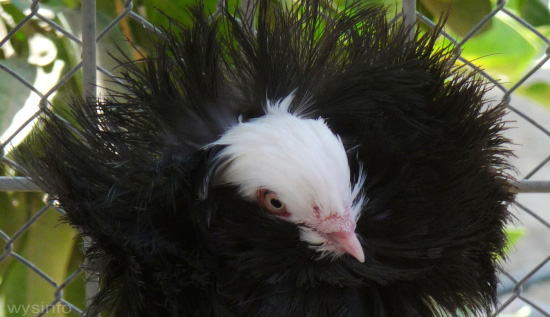
Pigeon fanciers have been studying, breeding, exhibiting and racing pigeons for hundreds, possibly even thousands, of years. The existence of associations that support pigeon fanciers certainly also dates back as many years. There are records in England of the “Ordinances for Judging Almond Tumblers” that refer back to 1764.
These ‘Pigeon fancier’ associations help educate breeders about caring for their pigeons – what is the best food for each type of pigeon, what diseases pigeons suffer from and how to treat them, etc. They also facilitate identifying and locating specific types of pigeons and organizing pigeon shows that enable breeders to meet.
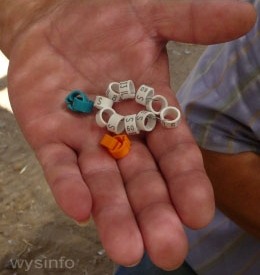
Each pigeon is tagged on birth, usually with colored leg rings. These rings provide information such as a code for the Association that the breeder belongs to (if applicable), a unique serial number for the pigeon and the year of birth of the pigeon.
If you find a pigeon that appears lost and it has a ring, you can contact any local association for help in identifying that pigeon’s owner.
Often the associations set up competitions to award prizes for the degree to which breeders can perfect the special characteristics of a pigeon type.
Pigeon associations in each country are generally responsible for defining and maintaining the standards for the pigeons that are associated with that country. For example, you would refer to the appropriate associations when checking standards for a Hungarian Pouter, English Nun or a Danish Tumbler Pigeon.
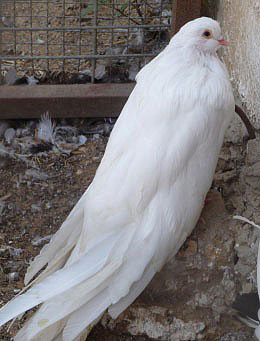
Antique Hungarian Pouter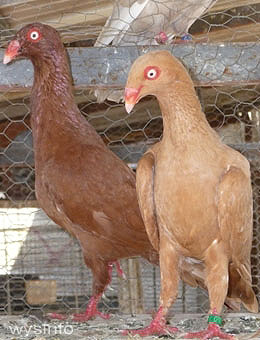
Danish Tumblers
Committees are established to deal with matters relating to the recognition of new breeds and varieties. Generally a classification is acknowledged only after the characteristic is successfully reproduced over a number of generations.
However, with current communication, connections and ease of movement, you can now find fanciers who breed different varieties of pigeons from all over the world. You can find, for example, Persian tumblers in England, English Nuns in Israel, Ukrainian high flyers in Canada.
As a result, new variations of breeds may be developed in countries other than the country of origin. The association within the country of origin may not recognize the new variation as fitting their standards for that breed. As a consequence, there is some degree of confusing nuances where similar pigeons have different names or different pigeons share similar names.
Also, one can find associations and clubs that are dedicated only to a specific type of pigeon. For example there are ‘Fantail Pigeon Clubs’ and ‘Magpie Pigeon Associations’ which set up standards for these particular types of pigeons.
How are pigeons categorized?
Sometimes pigeons are named by country of origin, sometimes by their characteristics, sometimes by functionality and sometimes even based on the name of the breeder.
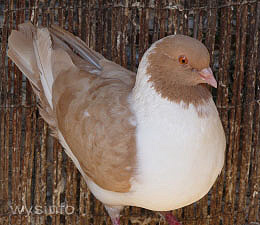
Modena Pigeon
Hungarian Giant House Pigeons
James C. Lyell wrote in his book on Fancy Pigeons (written in 1887) about the Modena pigeons, also called ‘Triganica Pigeons’
“…In the city of Modena the sport of pigeon-flying has been in vogue from time immemorial. Those who are devoted to this sport are called Triganieri, and the bird they employ is known as the triganica, or Triganina Pigeon. Historical evidence carries the sport back to the year 1327 …… In the Latin poem, De Aucupio Coternicum, by the Modenese, Seraphino Salvarani, published in 1678, there is a fine description of the method in which the Triganieri carry on thier aerial warfare…”
Standards for pigeons refer to the size of the pigeon, color, spread of coloring, number of feathers in the tail or wings as well as other qualities such as the angle of the beak compared to the head, the eyes, the color of the eyes, the color and structure of the beak.
Also, when relevant, leg feathering is checked for size and number of feathers and density.
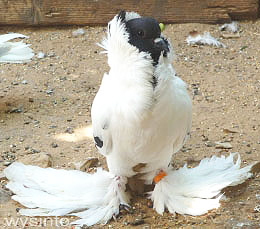
Schmalkalden Moorhead (black headed Pigeon)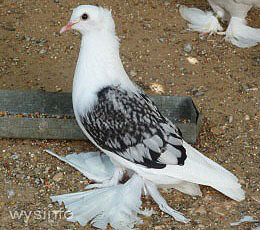
Saxon Shield
As a whole, there are endless small details that must be taken into consideration when evaluating a pigeon.
You can find detailed specifications for evaluating whether a pigeon meets the classification standards which have been set by the various associations.
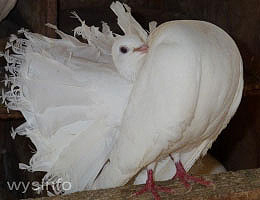
White Fantail
Beige Fantail
The following is an example of standards for Indian Fantail pigeons, as set by the Indian Fantail Club Of America in 1980:
“Standard for the Indian Fantail Pigeon
As Adopted June, 1980, by the Indian Fantail Club Of America
Revised July, 1985
The judging of the Indian Fantail is divided into six main areas as follows: stance, tail, body, condition, color and markings. The allocation of points total 100 and describes the ideal toward which we are striving. Balance is of primary importance, with the dominating factor to be an all-balanced bird. A breakout of points and detailed description of each area follows:
I. Stance – 15 points – Proper stance reflects a harmonious blending of all parts, providing balance and a natural stylishness. The carriage of the head and neck should be such that they are perpendicular to the ground with the eyes directly above the tips of the toes when the bird stations itself. The tail should be carried upright at a slight angle or tilt away from the front of the bird. The bird must stand solid on its feet, not on the tip of its toes. Body carriage should give the impression of levelness. As a guide the angle of the body should be 20 degrees up from the horizontal.
Faults:
1. Carrying breast too high
2. Head carried back too far
3. Tail carried too nearly parallel to the ground or tipped too far forward
4. Shaking of neck
II. Tail – 30 points – The tail should be large, full, round, held upright and cover from 3/4 to 7/8 of a complete circle. Tail feathers should reach 1 1/2 to 2 inches above the top of the head. The tail should not be perfectly flat, but saucer shaped. A double layer of tail feathers is to be preferred.
Faults:
1. Cone-shaped or scoop tail
2. Feathers making less then 3/4 of a complete circle
3. Splits on the tail sides caused by flight feathers
4 Excessive twisting of tail feathers so that they do not lie flat.
III. Body – 30 points
A. Size – 5 points
A medium size bird about 14 to 18 ounces.
When all else is equal, the advantage should go to the larger bird.
B. Head, Eyes & Neck – 5 points
The head must be full and round in proportion to the rest of the body.
In all cases both eyes must be the same color.
The neck is medium in length and full in feather.
Faults: 1. Shaking of neck
C. Crest – 5 points – The base of the crest must be in direct line with the eyes and beak setting.
Peak crest, as seen in an Archangel or Turbit, to be preferred, or a small shell crest.
D. Breast and Back – 5 points – The breast must be round and full. Breast feathers are to cover wing butts.
The back must be medium in length and width, leaving about a 1 1/2 inch space between the head and tail when at station, standing naturally.
E. Legs, Muffs, and Flights – 5 points – The legs are medium in length.
The muffs are full-feathered and about two inches in length, with hock feathers to match.
The feathering must be sufficient to cover all toes.
Flights should be carried under the tail but should not drag on the ground.
Faults: 1. Bare toes/feet or excessively overmuffed.
F. Feather Texture – 5 points – Feathers to lie smoothly and to be medium to hard in texture. Feathers to be broad, especially the main tail feathers. The backing feathers of the tail are to fit closely against the tail.
IV. Condition – 5 points – The bird should be healthy, alert, clean and free of parasites.
V. Color – 10 points – Recognizing the difficulty in achieving superior color, if other points are equal, preference be given to a superior colored bird in the self classes. All colors to be rich, lustrous and pure, with as little smut as possible and with a maximum of sheen. In all colors the ground color becomes darker as progression is made from barred, to check, to T pattern. All self colored birds to be evenly colored throughout.
Colors to include the intense and dilute versions of each.
Recognized Colors are as follows:
1. Blue – barless, barred, check, T pattern and spread in intense and dilute.
2. Brown -barred, check, spread in intense and dilute.
3. Ash red – barred and check, intense and dilute
4. Recessive Red
5. Recessive Yellow
6. Gold
7. Powdered
8. Lavender
9. Indigo
10. Grizzle
11. Almond
12. White
13. Other color modifiers as they are bred into the Indian Fantail
Beak and nail colors to be harmonious with plumage color: dark-colored birds to have dark beak and nails and light-colored birds to have lighter beak and nails.
VI. Markings – 10 points
A. Classes for recognized colors and markings are as follows, and all birds identifiable to a particular color or marked class are to be shown in that class even if they do not meet full requirements. Recognizing the difficulty in achieving correctly-marked birds, if other points are equal, preference should be given to a well-marked bird.
1. Solid Selfs – black, dun, brown, khaki and recessive red and yellow.
2. Patterned Selfs – in blue, ash red and brown; barless, barred, checked and T pattern
3. White – an all white bird
4. Bodymark – all white main tail with colored body
5. Saddle – all white bird with colored wing shield; primary flights are white and secondaries, colored
6. Tailmark – all white body with a colored main tail
7. Ribbontail – solid-colored body and tail except for a 1/2″ and 3/4″ white or near-white ribbon or band running continuously across every feather of the tail. The band should be 1/2″ to 1 ” from the tips of the tail feathers
8. Almond – any pigment, T pattern, almond factor
9. Splash – This class to include partially colored birds having at least 40% of their body covered with white feathers in a random pattern. This class should not include any bird that is recognizable as a mismark of a recognized color, mark or pattern.
10. A. O. C. (any other color) – This class is to include all new colors such as indigo, grizzle, gold, spread lavender and new markings such as whiteside and monk marked as well as any other new or experimental colors and marks.
B. New classes are to be created for any colors or marks, whether described above or not, when there are eight birds in that color or marking in a show exhibited by two or more exhibitors.
Disqualifications
1. A split in the center or top of the tail
2. A crooked or slanted tail
3. Eyes not of the same color or split-colored eyes.
4. No crest
5. Lacing of tail feathers
6. Any cut feathers
7. Any excessive plucking
8. Any sick bird
9. Any crippled or maimed bird
10. Excessive signs of parasites
Note: AOC is not shown. It stands for All Other Colors.
New colorations and markings will be included as numbers justify.”
Related Links
AviBirds.com Fantail Pigeon
